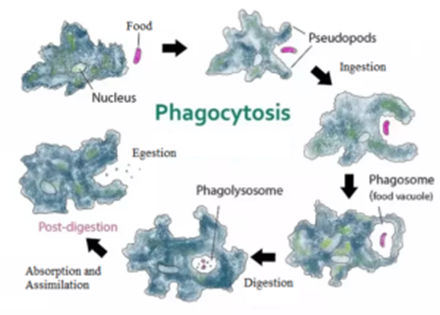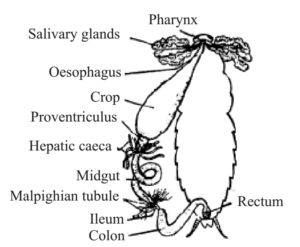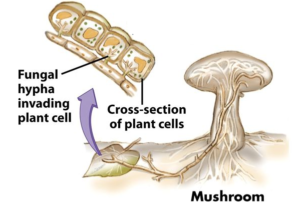Science > Biology > Digestion and absorption in Human > Nutrition
Energy is required by living beings for performing different activities. Energy is contained in the food. Food can be defined as a collection of chemicals taken by an organism for the purpose of the growth, repair, and replacement of body cells, energy releases, and maintenance of all the life processes. The process by which organisms obtain and utilize food for their growth, development, and maintenance is called nutrition and the chemical constituents present in the food are called nutrients. Digestion is the breaking down of complex constituents of food by enzymes into simpler soluble forms that can be absorbed and utilized by the cells of the body.
Types of nutrition:
Autotrophic Nutrition:
It is a type of nutrition in which organisms synthesize their energy sources that are high energy organic molecules (food) from low energy inorganic raw materials available in their surroundings. The chief source of carbon and nitrogen are carbon dioxide and nitrates. Green plants (containing green pigment chlorophyll) and certain bacteria can manufacture their own food (organic substances) from inorganic substances (CO2 and H2O) using energy from sunlight. This mode of nutrition is called autotrophic mode of nutrition. The result of autotrophic nutrition is the formation of glucose.
Green plants and plants like blue-green algae and bacteria such as cyanobacteria are considered to be examples of autotrophs.
Symbiotic Nutrition:
In this case, two organisms or animals might live in association and derive nutrition from each other. This dependence on each other is called mutualism. For example, Escherichia coli that lives in the intestine of man synthesizes vitamin B12 which is used by man and E. coli receives in return, simpler food from the intestine of man. Rhizobium bacteria living in the roots nodules of leguminous plants fix atmospheric nitrogen in nitrates form in the soil, which is absorbed by the plant. Nitrates are useful for the growth of the plant. In turn, the rhizobium bacteria gets nutrition from the plant. In lichens fungus in it absorb moisture from the atmosphere and give into the algal part. In turn, it gets food from algae.
Heterotrophic Nutrition:
In this mode of nutrition the food (organic and inorganic substances) obtained by feeding on other organisms. Heterotrophic Nutrition is further classified as holozoic nutrition, saprophytic nutrition, and parasitic nutrition.
- Holozoic Nutrition: In this mode, the organisms engulf the food into the body, digest it and absorb the soluble products of digestion, e.g. humans.
- Saprotrophic Nutrition: Some organisms do not ingest solid food. Such organisms secrete digestive enzymes on to dead or decaying organic matter and absorb the products of digestion. The food is digested outside the body of the organism. e.g. certain bacteria and fungi. Other examples are spiders, houseflies, etc.
- Parasitic Nutrition: In this mode, the food is derived from other living organisms by living on or inside their bodies. The parasites thrive on liquid food materials obtained from the body of the host. The host may or may not suffer as a result of this relationship. e.g. certain bacteria, roundworm, tapeworm, Cuscuta, Plasmodium, Trypanosoma, Taenia, and Ascaris, etc.
Types of Nutrients:
Nutrients include both organic and inorganic compounds. The organic compounds include carbohydrates, proteins, fats, and vitamins. Inorganic compounds contain minerals and water.
Depending upon the quantity of nutrients in food the nutrients are classified as macronutrients and micronutrients.
- Macronutrients: Those nutrients which are needed in large amounts are called macronutrients. Carbohydrates (sugar), lipids (fats), and proteins are macronutrients. They are the main source of energy and source of carbon (sugars) and organic nitrogen (amino acids) to the organism.
- Micronutrients: They are nutrients which are needed in a small amount. Vitamins and minerals are micronutrients. They play important roles in human development and well-being, including the regulation of metabolism, heartbeat, cellular pH, and bone density. Lack of micronutrients can lead to stunted growth in children and increased risk for various diseases in adulthood.
Nutrition in Animals
Animals are heterotrophs and hence they depend on other organisms (plants and other animals) for their food. All animals can be divided into three groups on the basis of their food habits. These are:
- Herbivores: Those animals which eat only plants are called herbivores. Examples are Goat, Cow, and Deer etc.
- Carnivores: Those animals which eat only other animals as food are called carnivores. Examples are Lion, Tiger, and Lizard etc.
- Omnivores: Those animals which eat both, plants and animals are called omnivores. Examples are Man, Dog and Crow etc.
Steps in Animal Nutrition (Holozoic nutrition):
The breakdown of complex food constituents and their absorption is accomplished by the digestive system. The processes involved in nutrition are:
Ingestion:
In this step, food is taken from outside into the alimentary canal through the mouth. It involves taking in food, chewing or sucking it and swallowing. These animals are variously adapted, both internally and externally, fo the ingestion of the specific type of food they take in. Depending upon the gross size of food, feeding in animals is classified into two categories: Microphagy (feeding on microscopic organisms: e.g. Amoeba, Paramoecium) and macrophagy (feeding on larger forms of organisms, e.g. the majority of chordates and some non-chordates).
Digestion:
It is the breaking down of complex constituents of food by enzymes into simpler soluble forms that can be absorbed and utilized by the cells of the body. In this step, the covalent bonds in the organic food molecules like carbohydrates, lipids, protein, and carbohydrates are broken down by the process of hydrolysis. Different enzymes act as a catalyst at different stages of digestion.
Absorption:
The absorption step involves absorbing digested food through the intestinal wall to reach the body tissues.
Assimilation:
These absorbed molecules are then used for the construction of their own molecules or body substances. Utilization of digested food nutrients by the body tissues for energy and synthesis of new protoplasm for growth and repair.
Egestion:
The whole food which we eat is not digested by our body, a part of the food remains undigested which cannot be used by the body and so it is removed from the body. The process of removal of undigested and unabsorbed food from the body is called egestion or defecation.
Types of Digestion:
Generally, two types of digestion are seen in heterotrophs: (a) Intracellular (b) Extracellular
Intracellular Digestion (Intra = inside):
In this type of digestion, all the five steps of nutrition (ingestion, digestion, absorption, assimilation, and egestion) occur inside the cell itself, as in Amoeba, Paramecium and other unicellular animals. Intracellular digestion is defined as the process in which animals that lack a digestive tract bring food items into the cell for digestion and for nutritional needs.
Intracellular digestion in Amoeba:

Food particles such as minute bacteria are enclosed (caught) by pseudopodia to form a food vacuole (Ingestion). Enzymes from the cytoplasm are secreted into the food vacuole (phagosome) to break down complex food. (Digestion). The food vacuole changes into a digestive vesicle (phagolysosome) within a cell by the fusion of phagosome containing ingested material and a lysosome containing hydrolytic enzymes. It leads to the digestion of food.
Digested food is absorbed into the cytoplasm. (Absorption). The absorbed food is used up wherever required in the cell. (Assimilation). The undigested unabsorbed food is expelled, when the food vacuole comes near the cell surface and bursts open. (Egestion). Food vacuoles are temporary structures and every time the Amoeba feeds, a new food vacuole is produced.
Extracellular Digestion (extra = outside):
In this type, the digestion occurs outside the cell. All animals (excluding sponges) carry out extracellular digestion.
The animals showing extracellular digestion have either a cavity, a tube, or a food canal (alimentary canal) which receives the ingested food. Digestive enzymes are poured over the food during its passage through the alimentary canal, and the products of digestion are absorbed back into the cells through the walls of the intestine. The undigested, unabsorbed food is thrown out of the digestive cavity.

Fungi and other decomposers perform extracellular digestion. They suck the life out of their host by releasing chemicals which break down the food they are living on. Once broken down their cells absorb the nutrients released.

Joint Intracellular and Extracellular Digestion:
In Hydra and other Cnidarians, the food (tiny prey) is caught by the tentacles and ingested through the mouth into the single large digestive cavity, called a gastrovascular cavity.

Enzymes are secreted from the cells bordering this cavity and poured on the food for extracellular digestion. Small particles of the partially digested food are engulfed into the vacuoles of the digestive cells lining the gastrovascular canal for intracellular digestion. Any undigested and unabsorbed food is finally thrown out of the mouth.
Next Topic: Alimentary canal: Brief Idea
7 replies on “Nutrition”
Nice facts 😉
I am very happy for this explaination
The explanations are very okay
I really love the explanation
clear explanation i love it
Thanks for this sweet explanation
I love it is easy to understand